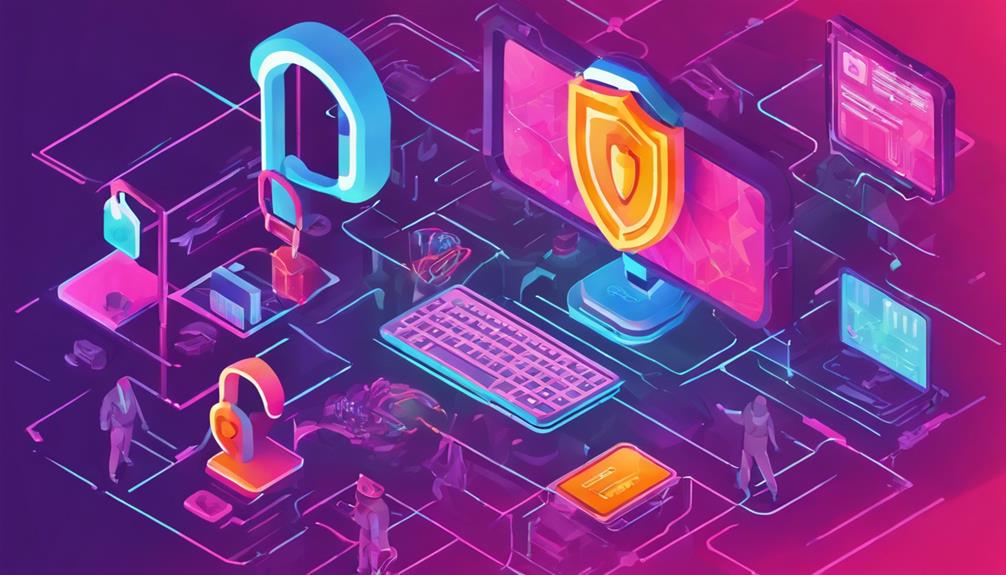Signal is safe from hackers due to its strong encryption and privacy measures. False vulnerability rumors have been refuted by cybersecurity experts. End-to-end encryption guarantees data security, and regular updates bolster messaging protection. Signal's security features include storing messages only on devices and employing secure enclaves for contact information. Recent incidents emphasized the importance of robust security protocols. To learn more about Signal's security measures and how they combat potential vulnerabilities, explore the detailed information available in reputable cybersecurity sources.
Key Takeaways
- Signal employs end-to-end encryption for secure messaging.
- False vulnerability rumors lack concrete evidence.
- Regular updates bolster Signal's security measures.
- Recent incidents highlight risks from third-party services.
- Signal promptly addresses security concerns for user protection.
Signal's Vulnerability Rumors Debunked
Dismissing the speculative rumors, Signal's president unequivocally refuted any claims of vulnerability in the app.
Despite false alarms circulating about an undisclosed vulnerability in Signal, cybersecurity experts highlighted the lack of concrete evidence to support such assertions.
While a previous vulnerability in Twilio, Signal's service provider, did impact some users, it was swiftly addressed and remedied.
The discussions surrounding the speculated high price for a zero-day vulnerability in Signal raised concerns within the cybersecurity community.
Cybersecurity researchers cautioned against the dissemination of unverified claims, emphasizing the importance of verifying information before spreading potential misinformation.
Signal's commitment to security remains steadfast, with the company continuously working to enhance its encryption protocols and address any potential vulnerabilities promptly.
Therefore, the rumors regarding Signal's susceptibility to security risks have been debunked, reassuring users of the app's dedication to maintaining a secure platform for communication.
Importance of Cybersecurity Verification

Validating cybersecurity claims is imperative to uphold the integrity of information shared within the cybersecurity community. When it comes to secure messaging apps like Signal, ensuring their security is paramount to safeguard the privacy of users' messages. Without proper verification, potential risks may go undetected, leading to vulnerabilities that hackers could exploit.
Cybersecurity professionals hold the responsibility of verifying and debunking cybersecurity news to prevent the spread of false information. False vulnerability reports not only impact user trust in secure messaging apps but also pose serious security risks. Such misinformation can tarnish the reputation and credibility of the affected service, highlighting the importance of thorough verification processes.
Caution should be exercised before sharing cybersecurity news to prevent the dissemination of inaccurate information. By verifying the security claims of messaging platforms like Signal, the cybersecurity community can work towards enhancing overall security practices and maintaining the trust of users in secure communication channels.
User Trust Impact of False Reports

Misinformation regarding vulnerabilities in Signal can greatly diminish user trust in the app's security measures. When false reports circulate, they can have a detrimental effect on Signal's reputation and user confidence.
To understand the impact of false reports on user trust, consider the following:
- Doubts in Security: False reports create uncertainty about the reliability of Signal's security protocols.
- Trust Erosion: User trust can be eroded by the spread of unsubstantiated claims regarding Signal's vulnerabilities.
- Importance of Verification: It is essential to verify cybersecurity news before sharing to prevent the dissemination of false information.
- Preserving Reputation: False reports can undermine Signal's reputation, highlighting the need for accurate reporting to maintain user trust.
Maintaining user trust is essential for Signal's continued success, and combating false reports is necessary in safeguarding the app's credibility in the cybersecurity domain.
Role of Cybersecurity Professionals

Cybersecurity professionals play a pivotal role in upholding the integrity and security of digital platforms by verifying and debunking false vulnerability reports. Their expertise is critical in evaluating the credibility of security claims, particularly in encrypted platforms like Signal, which use end-to-end encryption and the Signal Protocol to secure communications.
By collaborating and sharing insights, cybersecurity professionals help maintain the trustworthiness of cybersecurity news and reports. They contribute greatly to enhancing the overall security posture of digital platforms, providing accurate analysis to safeguard against potential security threats.
Additionally, their guidance on best security practices is paramount in ensuring user trust and educating individuals and organizations on effective security measures. In the domain of cybersecurity, the role of these professionals is indispensable in protecting the integrity of digital systems and combating emerging cyber threats.
Enhancing Message Protection Measures

To enhance message protection measures on Signal, users should conduct an encryption strength analysis to guarantee robust security.
Keeping up with security patches updates is essential for addressing any vulnerabilities promptly.
Additionally, adhering to Signal's privacy policy guidelines is vital for maintaining compliance and safeguarding messages.
Encryption Strength Analysis
An in-depth analysis of Signal's encryption strength reveals the robust measures in place to enhance message protection for users.
- Signal employs end-to-end encryption, securing data from sender to recipient, preventing unauthorized access to messages.
- The Registration Lock feature adds an extra layer of security by requiring a PIN for re-registration, enhancing message privacy.
- Contact information is stored in secure enclaves on devices, ensuring that user data remains protected and inaccessible to external sources.
- Users can configure Signal settings to control profile visibility, last seen status, and read receipts, further enhancing message protection measures.
Security Patches Update
Users are strongly encouraged to promptly update Signal to benefit from the latest security patches that enhance message protection measures. Regularly updating the Signal app is vital to address vulnerabilities and strengthen the overall security of messaging. By installing these updates, users can mitigate potential risks and maintain a safer communication environment.
Enabling features like Registration Lock within the Signal settings can add an extra layer of security to the account, preventing unauthorized access. Configuring privacy settings in Signal for messages and contact information also improves user protection against potential threats.
To further safeguard Signal from malware attacks, users can consider installing security apps on their smartphones. Staying informed about the latest privacy features and consistently updating Signal settings can greatly contribute to maintaining the integrity and confidentiality of messages shared through the platform.
Privacy Policy Compliance
Adherence to Signal's privacy policy plays a pivotal role in enhancing message protection measures for users of the platform. Ensuring compliance with the privacy settings and guidelines set forth by Signal is essential in maintaining the security and privacy of personal data shared within the communications app. To enhance message protection measures effectively, consider the following steps:
- Enable Registration Lock: Utilize Signal's Registration Lock feature within the app settings to prevent unauthorized access to your account, adding an extra layer of security.
- Configure Privacy Settings: Customize Signal settings to maximize privacy protection, safeguarding your messages and personal information from potential threats.
- Install Security Apps: Enhance security by installing reputable security apps on your smartphone to prevent malware attacks on Signal and other sensitive data.
- Stay Informed: Regularly update yourself on privacy features and updates within Signal to stay abreast of the latest protective measures for a secure messaging environment.
Comparing Signal Security Features

Signal's security features outshine many other messaging platforms due to its robust end-to-end encryption and secure storage practices. Messages are protected through end-to-end encryption, ensuring that only the sender and recipient can access message content.
User messages are stored solely on devices, not on servers, enhancing privacy and security. Additionally, Signal's contact information is safeguarded in secure enclaves, prioritizing the protection of users' contact lists.
To add an extra layer of security, Signal offers the Registration Lock feature, which requires a PIN to re-register a phone number with the service, preventing unauthorized access. It is worth noting that a recent attack targeting Signal was aimed at a less secure service provider, not Signal directly, highlighting the platform's strong security measures.
Addressing Privacy Concerns in Messaging

Amid growing concerns surrounding privacy in messaging platforms, it is essential to address the strategies and measures implemented by service providers to uphold user data security.
When using Signal, a messaging platform known for its strong security features, users can feel confident in their privacy.
To address privacy concerns effectively, companies that provide messaging services, such as Signal, have implemented the following measures:
- End-to-End Encryption: Signal Messages are encrypted from sender to receiver, ensuring that only the intended recipient can access the content.
- Secure Storage: Contact information in Signal is stored in secure enclaves, enhancing user privacy and data protection.
- Registration Lock Feature: Users can provide extra protection to their messages by enabling the Registration Lock feature in Signal settings.
- Robust Security Measures: Recent incidents have shown that even when targeted, Signal's security remains strong, as the attack targeted a less secure service provider and not Signal directly.
Implications of Recent Security Incidents

The recent security incidents at Signal have raised concerns about the platform's vulnerability to unauthorized access. Approximately 1900 user accounts were compromised due to attackers exploiting Twilio for authentication codes, impacting Signal's privacy-conscious user base greatly.
The security breach stemmed from the use of phishing tactics to obtain Twilio employee credentials, allowing unauthorized access to Signal accounts. In response, Signal promptly advised users to update their app immediately to bolster security measures.
This incident underscores the importance of robust security protocols in safeguarding user data on messaging platforms like Signal. It also highlights the potential risks associated with third-party services like Twilio, which can be targeted by malicious actors seeking to compromise user accounts.
Moving forward, vigilance and proactive security measures are essential to mitigating the threat of unauthorized access and ensuring the protection of user information on Signal and similar platforms.
Frequently Asked Questions
Is Signal Really That Safe?
Signal's robust security measures, including end-to-end encryption, limited data storage, transparency in code, and Registration Lock, contribute to its reputation for safety. These features collectively bolster user trust in the platform's commitment to safeguarding communication integrity.
Is Signal Truly Anonymous?
Signal provides a high level of anonymity through its encryption protocols, minimal data storage practices, and nonprofit structure. Its commitment to user privacy and transparency, reinforced by open-source code, establishes Signal as a trustworthy platform for anonymous communication.
Is Signal Still Secure in 2024?
Signal's security in 2024 remains robust, supported by end-to-end encryption and proactive security measures. The platform's ongoing commitment to privacy and user protection underscores its dedication to maintaining secure communication channels amidst evolving cybersecurity challenges.
Has Signal Ever Been Hacked?
Signal has not been hacked regarding its core encryption being compromised. While attackers exploited vulnerabilities in third-party services, Signal's robust security measures have prevented direct hacking of its encryption protocols, ensuring user data remains secure.
Conclusion
In summary, the truth about Signal's security measures has been revealed, dispelling rumors of vulnerability.
Cybersecurity verification is essential for maintaining user trust and protecting sensitive information.
It is vital that cybersecurity professionals continue to enhance message protection measures to address privacy concerns in messaging platforms.
Recent security incidents highlight the importance of staying vigilant and proactive in ensuring the security of our communications.
Trust in Signal's security features remains strong, providing users with a reliable and secure messaging platform.









